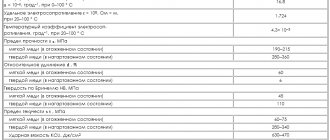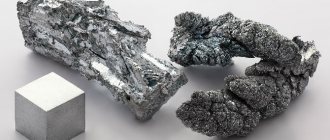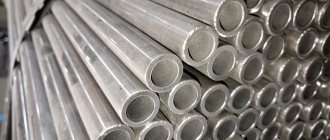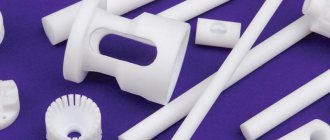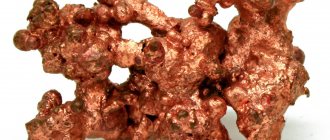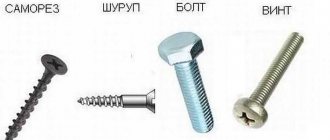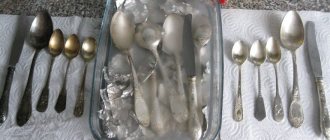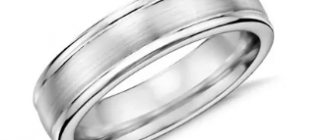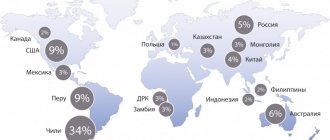Native copper measuring about 4 cm
Copper
- a mineral from the class of native elements. Fe, Ag, Au, As and other elements are found in natural minerals as impurities or forming solid solutions with Cu. The simple substance copper is a ductile transition metal of golden-pink color (pink in the absence of an oxide film). One of the first metals widely mastered by man due to its relative availability for extraction from ore and low melting point. It is one of the seven metals known to man since very ancient times. Copper is an essential element for all higher plants and animals.
- Structure
- Properties
- Reserves and production
- Origin
- Application
- Classification
- Physical properties
- Optical properties
- Crystallographic properties
See also:
Gold
— structure and physical properties
Aluminum
— structure and physical properties
STRUCTURE
Crystal structure of copper
Cubic system, hexaoctahedral type of m3m symmetry, crystal structure - cubic face-centered lattice. The model is a cube of eight atoms in the corners and six atoms located in the center of the faces (6 faces). Each atom of a given crystal lattice has a coordination number of 12. Native copper occurs in the form of plates, spongy and solid masses, thread-like and wire-like aggregates, as well as crystals, complex twins, skeletal crystals and dendrites. The surface is often covered with films of “copper green” (malachite), “copper blue” (azurite), copper phosphates and other products of its secondary alteration.
PROPERTIES
Native copper crystals, Lake Superior, Kinawee County, Michigan, USA. Size 12 x 8.5 cm
Copper is a golden-pink ductile metal; in air it quickly becomes covered with an oxide film, which gives it a characteristic intense yellowish-red hue. Thin films of copper have a greenish-blue color when exposed to light.
Along with osmium, cesium and gold, copper is one of the four metals that have a distinct coloration that is different from the gray or silver of other metals. This color tint is explained by the presence of electronic transitions between the filled third and half-empty fourth atomic orbitals: the energy difference between them corresponds to the wavelength of orange light. The same mechanism is responsible for the characteristic color of gold.
Copper has high thermal and electrical conductivity (it ranks second in electrical conductivity among metals after silver). Specific electrical conductivity at 20 °C: 55.5-58 MS/m. Copper has a relatively large temperature coefficient of resistance: 0.4%/°C and is weakly dependent on temperature over a wide temperature range. Copper is diamagnetic.
There are a number of copper alloys: brass - with zinc, bronze - with tin and other elements, cupronickel - with nickel and others.
Mining of copper ores in the world
Copper mines are not concentrated in specific geographical areas, but are found in different countries. In America, chalcocite deposits are being developed in the states of Nevada and Arizona. Deposits of copper oxide – cuprite – are common in Cuba. Copper chloride is mined in Peru.
There are almost no sources of enriched ores left in the world; copper has been mined for several hundred years, so all the rich mines have long been developed. In industry it is necessary to use low-grade minerals (up to 0.5% copper).
Interesting! In terms of global production, copper is in third place after iron and aluminum.
Leading countries in copper ore reserves and production
The list of countries rich in copper ores includes: Chile, America, China, Kazakhstan, Poland, Indonesia, Zambia. The Russian Federation's share in world ore production is 9% (this is third place after Chile and the USA). Chile is the leader in mineral reserves, containing 33% of the world's copper.
The largest mines are:
- Chuquicamata mine (Chile). Development has been carried out for more than 100 years, during this period 26 million tons of metal were developed;
Recently, large mines were discovered in Peru (Antamina), Brazil (Salobu), and Kazakhstan (Nurkazgan).
Experts say that the volume of economically viable copper is more than 400 million tons. Worldwide.
RESERVES AND PRODUCTION
Copper specimen, 13.6 cm. Kinawi Peninsula, Michigan, USA
The average copper content in the earth's crust (clarke) is (4.7-5.5) 10−3% (by mass). In sea and river water the copper content is much lower: 3·10−7% and 10−7% (by weight), respectively. Most copper ore is mined by open pit mining. The copper content in the ore ranges from 0.3 to 1.0%. World reserves in 2000 were, according to experts, 954 million tons, of which 687 million tons were proven reserves; Russia accounted for 3.2% of total and 3.1% of confirmed world reserves. Thus, at the current rate of consumption, copper reserves will last approximately 60 years. Copper is obtained from copper ores and minerals. The main methods for obtaining copper are pyrometallurgy, hydrometallurgy and electrolysis. The pyrometallurgical method involves obtaining copper from sulfide ores, for example, chalcopyrite CuFeS2. The hydrometallurgical method involves dissolving copper minerals in dilute sulfuric acid or ammonia solution; From the resulting solutions, copper is replaced by metallic iron.
Copper connections
Copper oxide CuO(II):
- a red-brown solid, insoluble in water, exhibits basic properties;
- when heated in the presence of reducing agents, it gives free copper: CuO + H2 = Cu + H2O;
- copper oxide is obtained by the interaction of copper with oxygen or the decomposition of copper (II) hydroxide: O2 + 2Cu = 2CuO; Cu(OH)2 = CuO + H2O.
Copper hydroxide Cu(OH2)(II)):
- crystalline or amorphous substance of blue color, insoluble in water;
- decomposes into water and copper oxide when heated;
- reacts with acids, forming the corresponding salts: Cu(OH2) + H2SO4 = CuSO4 + 2H2O;
- reacts with alkali solutions, forming cuprates - complex compounds of bright blue color: Cu(OH2) + 2KOH = K2[Cu(OH)4].
For more information on copper compounds, see Copper oxides.
ORIGIN
Small nugget of copper
Typically, native copper is formed in the oxidation zone of some copper sulfide deposits in association with calcite, native silver, cuprite, malachite, azurite, brochantite and other minerals. The masses of individual clusters of native copper reach 400 tons. Large industrial deposits of native copper, along with other copper-containing minerals, are formed when volcanic rocks (diabases, melaphyres) are exposed to hydrothermal solutions, volcanic vapors and gases enriched in volatile copper compounds (for example, the Lake Superior deposit, USA). Native copper is also found in sedimentary rocks, mainly in cuprous sandstones and shales. The most famous deposits of native copper are the Turin mines (Urals), Dzhezkazgan (Kazakhstan), in the USA (on the Keweenaw Peninsula, in the states of Arizona and Utah).
How copper ore deposits are developed
Various types of rocks containing Cu, as well as nuggets, can be mined on the planet using two main technologies:
- closed;
- open.
In the first case, mines are built at the deposit, the length of which can reach several kilometers. To move workers and equipment, such underground tunnels are equipped with elevators and railway tracks. Rock crushing in mines is carried out using special drilling equipment with spikes. Copper ore is collected and loaded to be sent upstairs using buckets.
If the deposits are located no further than 400-500 m from the surface of the earth, they are mined using the open-pit method. In this case, the top rock layer in the field is first removed using explosive devices. Next, the copper ore itself is gradually removed.
This is interesting: Marquis canopy
APPLICATION
Copper bracelets
Due to its low resistivity, copper is widely used in electrical engineering for the manufacture of power cables, wires or other conductors, for example, in printed circuit wiring. Copper wires, in turn, are also used in the windings of energy-saving electric drives and power transformers. Another useful quality of copper is its high thermal conductivity. This allows it to be used in various heat removal devices and heat exchangers, which include well-known radiators for cooling, air conditioning and heating. Alloys using copper are widely used in various fields of technology, the most widespread of which are the above-mentioned bronze and brass. Both alloys are general names for a whole family of materials, which in addition to tin and zinc may include nickel, bismuth and other metals. In jewelry, alloys of copper and gold are often used to increase the resistance of products to deformation and abrasion, since pure gold is a very soft metal and is not resistant to these mechanical influences. The predicted new mass use of copper promises to be its use as bactericidal surfaces in medical institutions to reduce intra-hospital bacterial transfer: doors, handles, water stop valves, railings, bed rails, table tops - all surfaces touched by the human hand.
Copper - Cu
| Molecular weight | 63.55 g/mol |
| origin of name | From the Greek "Kyprium", that is, "Cypriot metal", after the name of the island of Cyprus |
| IMA status | valid, first described before 1959 (before IMA) |
Applications of metal: from telegraphs to fireworks
The widespread use of copper began after the invention of the telegraph. Huge amounts of metal were needed for telegraph wires. Since that time, our hero has not left first place in the ranking of electrical metals.
The use of copper is based on its properties. Electrical wiring in old houses; Now expensive metal is being replaced with cheap aluminum. But the devices contain copper wiring. Computers are equipped with copper heat sinks.
We recommend: NICKEL - the “stepson” in the family of silver metals
Plumbing equipment, refrigeration equipment, air conditioners - non-ferrous metal with its remarkable properties is used everywhere.
Ships and boats are proud of their copper pipelines (liquid and gas flow into them).
And in many countries, copper pipes are used for water and gas supply to buildings.
Without copper there will be no brazing solder (that's the "glue" for metals).
Dioskourides wrote: “Solder for gold is prepared from children’s urine and Cypriot copper.”
Japan considers copper gas pipeline pipes to be earthquake-resistant.
Copper is used as an alloy for gold alloys; Pure gold is a metal that is too soft and prone to abrasion.
Orange non-ferrous metal gives blue color to pyrotechnic products.
The service life of copper products reaches 200 years or more.
PHYSICAL PROPERTIES
| Mineral color | copper-red, fading to black or green in air |
| Stroke color | copper red |
| Transparency | opaque |
| Shine | metal |
| Cleavage | No |
| Hardness (Mohs scale) | 2,5-3 |
| Strength | malleable |
| Kink | jagged |
| Density (measured) | 8.94 - 8.95 g/cm3 |
| Radioactivity (GRapi) | 0 |
| Magnetism | diamagnetic |
Reserves in nature
Where can you mine copper in the wild today? Currently, deposits of this popular metal have been discovered on all continents of the Earth. At the same time, Cu reserves are considered to be practically unlimited. Geologists nowadays are finding more and more new deposits of pure copper, as well as ores containing it. For example, in 1950, world reserves of this metal amounted to 90 million tons. By 1970, this figure had already increased to 250 million tons, and by 1998 - to 340 million tons. Currently, it is believed that copper reserves on the planet amount to more than 2.3 billion tons.
CRYSTALLOGRAPHIC PROPERTIES
| Point group | m3m (4/m 3 2/m) - hexoctahedral |
| Space group | Fm3m (F4/m 3 2/m) |
| singonia | cubic |
| Cell Options | a = 3.615Å |
| Morphology | cubes, dodecahedrons and tetrahexahedrons; rarely octahedra and complex combinations; thread-like, tree-like |
| Twinning | {111} twins according to the spinel law |
Chemical composition of cast and deformed copper
| Brand / Alloy | Basis, no less | Impurities, no more | ||||||||||||||
| Copper | Copper+Silver | Bismuth | Iron | Nickel | Zinc | Tin | Antimony | Arsenic | Lead | Sulfur | Oxygen | Phosphorus | Silver | Selenium | Tellurium | |
| Cu | Cu+Ag | Bi | Fe | Ni | Zn | Sn | Sb | As | Pb | S | O | P | Ag | Se | Te | |
| M00b | 99,99 | — | 0,0005 | 0,001 | 0,001 | 0,001 | 0,001 | 0,001 | 0,001 | 0,001 | 0,001 | 0,001 | 0,0003 | 0,002 | 0,0005 | 0,0005 |
| M0b | — | 99,97 | 0,001 | 0,004 | 0,002 | 0,003 | 0,002 | 0,002 | 0,002 | 0,003 | 0,003 | 0,001 | 0,002 | — | — | — |
| M1b | — | 99,95 | 0,001 | 0,004 | 0,002 | 0,003 | 0,002 | 0,002 | 0,002 | 0,004 | 0,004 | 0,003 | 0,002 | — | — | — |
| M00 | 99,96 | — | 0,0005 | 0,001 | 0,001 | 0,001 | 0,001 | 0,001 | 0,001 | 0,001 | 0,002 | 0,03 | 0,0005 | 0,002 | 0,0005 | 0,0005 |
| M0 | — | 99,93 | 0,0005 | 0,004 | 0,002 | 0,003 | 0,001 | 0,002 | 0,001 | 0,003 | 0,003 | 0,04 | — | — | — | — |
| M1 | — | 99,9 | 0,001 | 0,005 | 0,002 | 0,004 | 0,002 | 0,002 | 0,002 | 0,005 | 0,004 | 0,05 | — | — | — | — |
| M1r | — | 99,9 | 0,001 | 0,005 | 0,002 | 0,005 | 0,002 | 0,002 | 0,002 | 0,005 | 0,005 | 0,01 | 0,002-0,012 | — | — | — |
| M1f | — | 99,9 | 0,001 | 0,005 | 0,002 | 0,005 | 0,002 | 0,002 | 0,002 | 0,005 | 0,005 | — | 0,012-0,04 | — | — | — |
| M2r | — | 99,7 | 0,002 | 0,05 | 0,2 | — | 0,05 | 0,005 | 0,01 | 0,01 | 0,01 | 0,01 | 0,005-0,06 | — | — | — |
| M3r | — | 99,5 | 0,003 | 0,05 | 0,2 | — | 0,05 | 0,05 | 0,05 | 0,03 | 0,01 | 0,01 | 0,005-0,06 | — | — | — |
| M2 | — | 99,7 | 0,002 | 0,05 | 0,2 | — | 0,05 | 0,005 | 0,01 | 0,01 | 0,01 | 0,07 | — | — | — | — |
| M3 | — | 99,5 | 0,003 | 0,05 | 0,2 | — | 0,05 | 0,05 | 0,01 | 0,05 | 0,01 | 0,08 | — | — | — | — |
By agreement with the consumer, it is allowed to produce M0b grade copper with an oxygen mass fraction of no more than 0.002%.
The designation of copper grades M1 and M1p, intended for the electrical industry and subject to testing for electrical conductivity, additionally includes the letter E.
It is possible to agree on the mass fraction of elements not indicated in the table.
Requirements for the physical properties of copper - electrical resistivity, helical elongation (ability to recrystallize under given heat treatment parameters), mechanical properties are established in standards for specific products and (or) by agreement of the parties.
